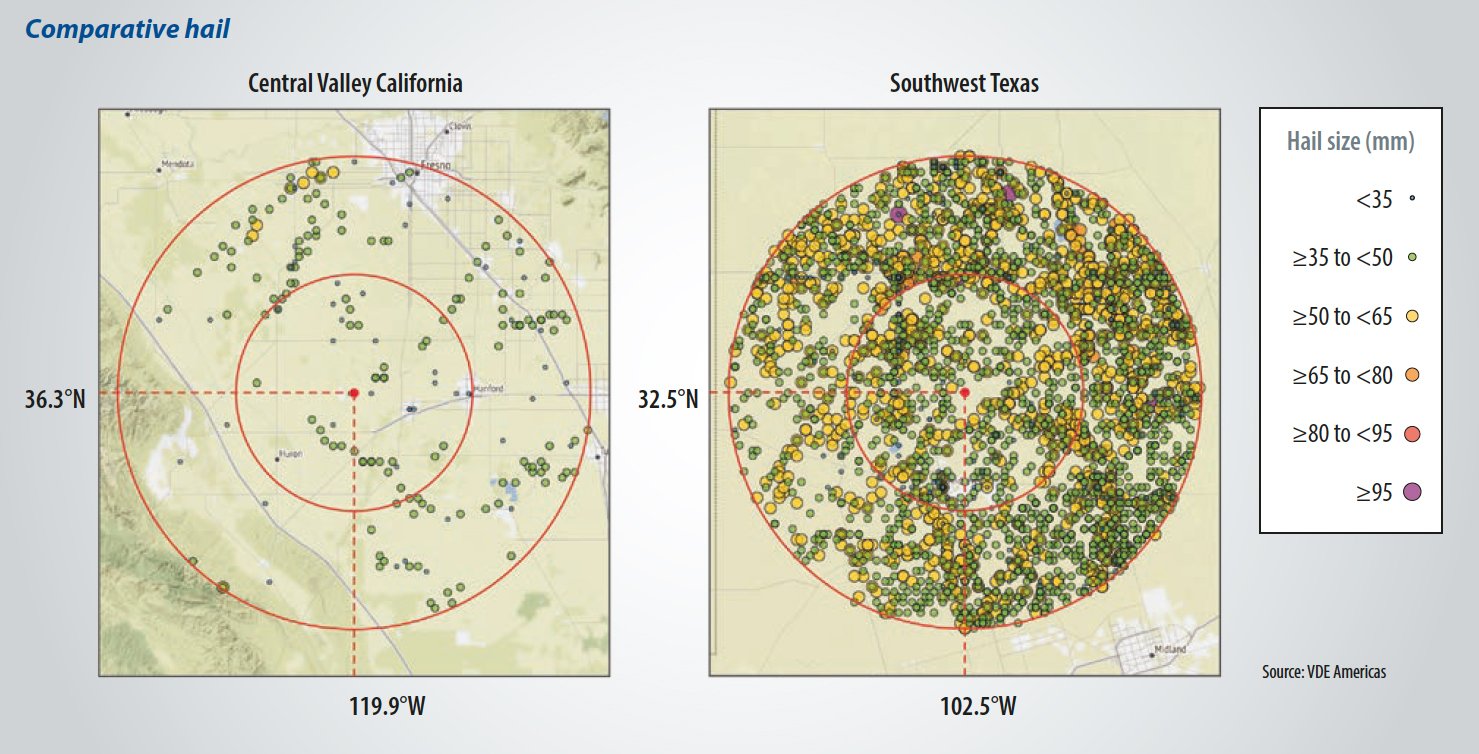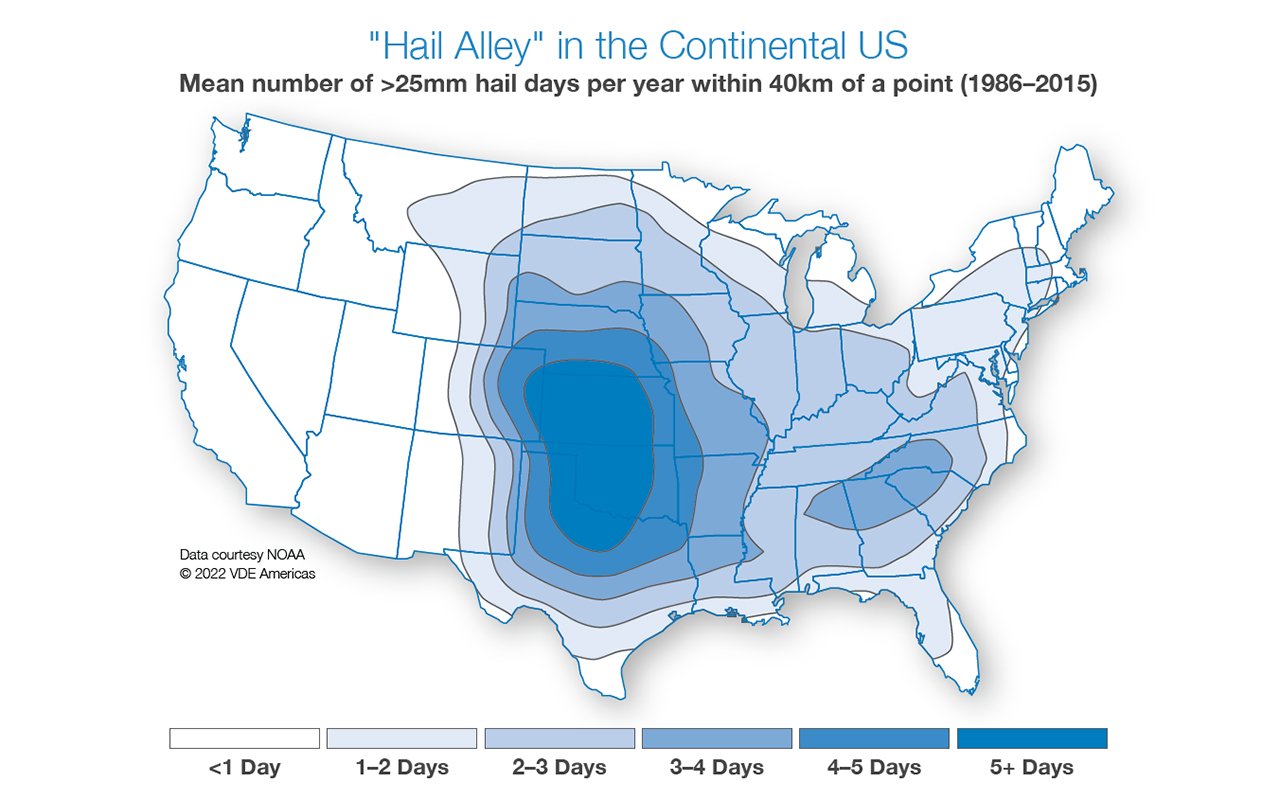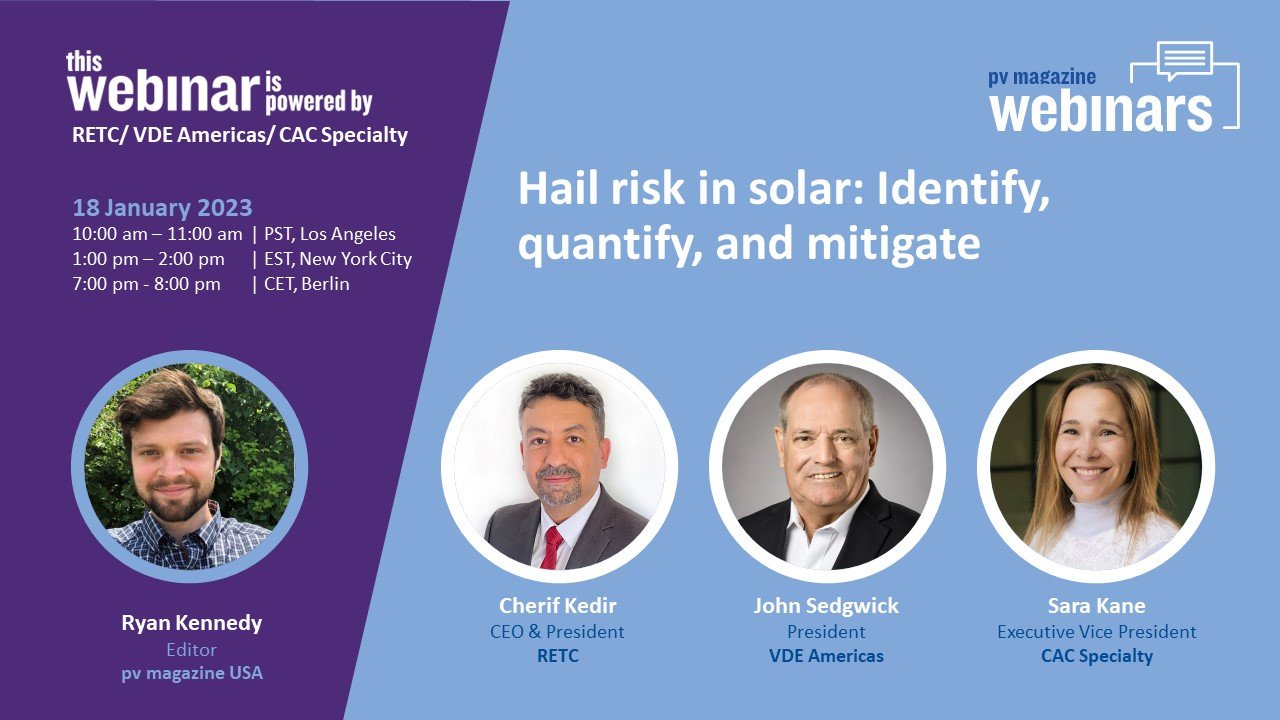Webinar | “Hail Risk in Solar” Assets
Fielding less-hail-resistant modules in more-hail-prone locations requires comparative test data, better risk mitigation practices, and rational insurance premiums.
Solar project hail risk is increasing due to a perfect storm of market and technology changes. On the technology front, PV modules are becoming less hail-resistant over time as manufacturers push the value-engineering envelope with larger format products and thinner front glass. Meanwhile, development is increasing in Texas and other hail-prone regions.
Join RETC, VDE Americas, and CAC Specialty for a pv magazine-hosted webinar on January 18, 2023. Our featured subject matter experts will share lessons learned about and best practices for identifying, quantifying, and mitigating severe hail risk based on project location and fielded PV module technology.
Who are the webinar presenters?



CHERIF KEDIR, CEO & PRESIDENT, RETC
Cherif is the CEO and president of RETC, an independent testing laboratory specializing in PV and energy storage products. A 15-year solar industry veteran, Cherif is a go-to expert on bankability and certification testing, product development and engineering, yield and performance enhancement, test site development, and product reliability and durability. Before RETC, Cherif worked on product engineering, testing, and failure analysis in the semiconductor industry.
JOHN SEDGWICK, PRESIDENT, VDE AMERICAS
John is a serial entrepreneur with over two decades of experience in renewable energy. In 2002, John co-founded Solaicx, a solar technology company with a proprietary process for the continuous growth of high-quality silicon ingots, and later played a key role in selling the company to SunEdison. In 2013, John co-founded VDE Americas, where he serves as president and leads the development of the company’s proprietary hail risk assessment and mitigation capabilities.
SARA KANE, EXECUTIVE VICE PRESIDENT, CAC SPECIALTY
Sara serves as the leader of the Power and Renewables team at CAC Specialty, a specialty insurance brokerage bringing bespoke insurance solutions to public and private corporations and private equity sponsors; she also heads Cirrus, CAC’s risk management consulting platform. Sara has 15 years of experience—working on all sides of the table—in the risk and insurance space with an extensive focus on power and renewables. Prior to CAC, Sara held leadership positions with Beecher Carlson, SunEdison, Axis Capital, GCube, and AIG.
What are the webinar topics?



HAIL DURABILITY TESTING
Cherif Kedir will explain how RETC’s Hail Durability Test (HDT) program helps project stakeholders better understand hail effects on PV modules in real-world applications by expanding upon UL and IEC standards with the goal of differentiating product designs.
Basic certification test standards are inadequate to identify project risks associated with severe hail. RETC developed its HDT program to close this gap. First, the program subjects modules to higher kinetic impact energies, to reflect the risk posed by hail over a 25- or 30-year operating life. Second, it thoroughly investigates a range of possible outcomes, providing valuable data for probabilistic analyses. Third, the test sequence is not limited to ballistic impact testing only; it also includes thermal cycle and hot-spot tests to reveal potential long-term module degradation modes.
By exposing PV modules to severe, very severe, and extreme hail strikes, the HDT sequence effectively investigates ballistic-impact resistance at the threshold of damage, just over this threshold, and at material failure. Quality assurance ensures consistent ice ball quality, repeatable impact velocities, and precise kinetic impact energies to maximize stakeholder confidence in the test results.
PROBABILISTIC HAIL RISK ASSESSMENT
John Sedwick will discuss how probabilistic hail risk assessments—informed by comparative hail durability test data—allow project stakeholders to identify and quantify location-specific perils associated with large-diameter hail.
Together with Dr. John Allen, an expert in hail forecasting, VDE Americas has developed rigorous science- and engineering-based hail risk analysis capabilities. This hail risk assessment approach uses intelligently hybridized weather data blending methodologies to combine the strengths of ground- and radar-based data. It uses statistical methodologies to account for hail return intervals and natural variances in kinetic energy associated with hailstone shape, density, and size. Lastly, it accounts for the fact that intelligently controlled single-axis trackers can implement defensive stow strategies that reduce hail impact energies.
Informed by these data, VDE Americas’ independent engineering analyses quantify the financial value of technology-specific risk mitigation approaches based on average annual loss (AAL) and probable maximum loss (PML) values. These data help the insurance and finance communities account for long-term probabilistic loss based on project-specific vulnerabilities.
INSURANCE PREMIUMS AND COVERAGE
Sara Kane will discuss the challenges associated with communicating probabilistic hail risk to the project finance and insurance communities.
Though hail risk assessment is essential to establishing proper insurance policy terms and pricing, it is often difficult for insurers to accurately account for hail risk. The limited historical loss data for PV projects is insufficient—based both on the length of time in the field and geographic distribution—to allow for meaningful statistical evaluations of site-specific perils. Due to the large value of solar project hail losses, today’s insurance market is characterized by high premiums and significant coverage limitations.
By partnering with VDE Americas, CAC Specialty provides bespoke analyses of the hail risks facing fielded solar projects. These comprehensive analyses of project risk ultimately advance our collective goal of deploying bankable solar assets by enabling sound financial assessments of potential risk-mitigation strategies and providing a rational basis for insurance prices and terms.


